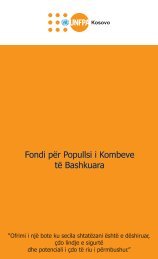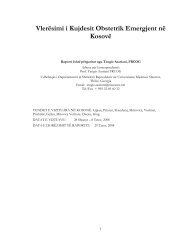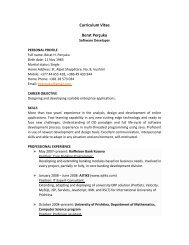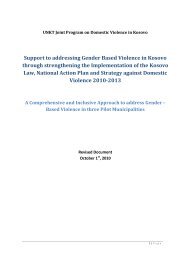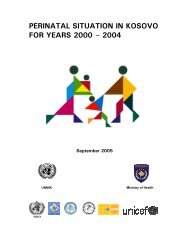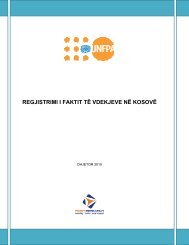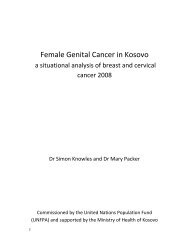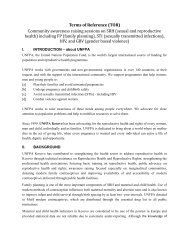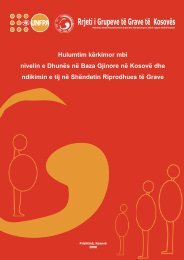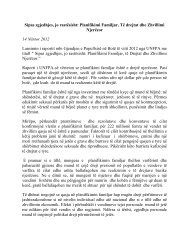Mimoza Dushi - UNFPA
Mimoza Dushi - UNFPA
Mimoza Dushi - UNFPA
Create successful ePaper yourself
Turn your PDF publications into a flip-book with our unique Google optimized e-Paper software.
Demographic Transition in Kosovo-<br />
Challenges and Opportunities<br />
Fertility Level in Kosovo<br />
( gender perspective)<br />
Dr. <strong>Mimoza</strong> DUSHI<br />
Prishtina, 03.11.2011
Content:<br />
• Introduction (Theory of demographic transition and Second<br />
demographic transition)<br />
• Demographic Transition in Kosovo<br />
• Change of level of natality<br />
• Readiness of women of Kosovo society to plan their families<br />
• Conclusion
Introduction<br />
• Socio-economic changes cause transformations in<br />
demographic development, in particular in determinates of<br />
natural movements<br />
• Theory of Demographic Transition - balance between mortality<br />
level ( under 30/1000) and natality ( under 30/1000<br />
- fertility in the replacement level<br />
– marriage<br />
– traditional methods for family planning<br />
• Second Demographic Transition (Van de Kaa, 1988)<br />
– fertility under replacement level<br />
– cohabitation<br />
– modern methods of family planning
Demographic Transition in Kosovo<br />
• In Kosovar society demographic flow marks a transformation,<br />
transition from para-transitional society into transitional<br />
• In the para-transitional society<br />
– fertility level was very high<br />
– main fields of economy were agriculture and farming ,<br />
• Requesting increase of labor force( including children)<br />
– Woman should have given birth constantly
• level of mortality falls under 30/1000 during 20’s<br />
promilë<br />
70<br />
60<br />
50<br />
40<br />
30<br />
20<br />
10<br />
0<br />
1911 1921 1931 1947<br />
f ertiliteti mortaliteti
Change of fertility level<br />
• After Second World War –immediate changes were<br />
unnoticed<br />
– Kosova still had the highest natality level in Europe<br />
approximately on average 50 per 1000<br />
– Approximately eight children per woman<br />
• Kosovar society continued to remain agricultural<br />
• Patriarchal family norms and traditional society were<br />
preserved
Change of fertility level<br />
Economic investments (heavy industry)<br />
processes<br />
household<br />
giving birth<br />
-need for male labor force<br />
-insuficient inclusion of woman in economical<br />
-continuing isolation of women within the<br />
-enough time to give birth and raise the children<br />
-she remains tide to her biological function,
• after 60’s<br />
Change of fertility level<br />
– start investments in economy (light industry)<br />
– Possibilities for women to enage in socio-economic<br />
processes<br />
• however, large number of deliveries shows that there<br />
are no big changes in economy and demography<br />
– the only improvement is decrease of infant mortality,<br />
as long as fertility rate remains unchanged<br />
– This period marks the biggest natural growth for<br />
Albanian population in Kosovo
– Fertility level under 30/1000 in the second half of XX Century<br />
promilë<br />
50<br />
45<br />
40<br />
35<br />
30<br />
25<br />
20<br />
15<br />
10<br />
5<br />
0<br />
1950 1960 1970 1980 1990 2000<br />
fertiliteti mortaliteti
• Real changes toward birth and number of descedants start only<br />
after year 2000<br />
– Rural-urban migration ( in particular after 1999 conflict)<br />
– change of country’s urban structure<br />
– change of economy<br />
• primary sectors replaced with tertiary sector<br />
• Creation of better condition for woman employment<br />
– has reached a certain level of individual and economic<br />
independence<br />
– her main objective is not anymore birth and child-bearing, but<br />
advancement of her career and use of free time<br />
• increased demand for qualified labor force<br />
– removal of children from work
• this situation spontaneously imposes need for family<br />
planning<br />
– late marriages<br />
– small number of children<br />
– use of different methods for prevention of preganancies<br />
numër<br />
9<br />
8<br />
7<br />
6<br />
5<br />
4<br />
3<br />
2<br />
1<br />
0<br />
7.85<br />
6.68 6.73<br />
6.02<br />
5.45 5.21<br />
4.82<br />
4.3<br />
3.6<br />
2.61<br />
2.2 2.2 2.1<br />
1950 1955 1960 1965 1970 1975 1980 1985 1990 1995 2000 2005 2010<br />
norma e fertilitetit të përgjithshëm
Readiness of Kosovo women to plan their<br />
families<br />
• concept is linked with two categories of questions,<br />
those for<br />
– family planning<br />
– Ability of women for decision making<br />
• Analyzed based on<br />
– demographic variables<br />
• age and marriage status<br />
– Socio-economic variable<br />
• level of education, employment, level of income<br />
and type of residence
• Family Planning –<br />
– In economical aspect – enables planning of number<br />
of children in accordance with family income<br />
– In social aspect – is preventive method in unplanned<br />
births especially in avoiding abortions<br />
– In medical aspect – represents curative methods in<br />
treatment of sterility<br />
• Abortion – method for interruption of pregnancy<br />
• Contraceptive methods – method for prevention of<br />
unplanned pregnancies
Demographic variables<br />
• marriage status and its time frame has more<br />
impact on women use of contraceptives<br />
– family planning is used more by elderly<br />
women who are married then younger and<br />
single<br />
• younger women might have uncertainties<br />
regarding their future pregnancies<br />
• Elderly women have reached preferred<br />
number of children
Socio-economic variables<br />
• educated and employed women who have<br />
managed to secure economic ground<br />
– actively participate in the family planning issue<br />
– coordinate time spend at work and with their families<br />
• Uneducated and unemployed have lower social<br />
status, mainly leave in rural settlements and<br />
large families<br />
– Without clear stands on reproductive behavior<br />
– Their families are “planned” by their husbands<br />
• they hinder their wife's to use contraceptive methods
• Educated and employed women mainly in<br />
urban settlements<br />
• Analysis shows the importance of labor status<br />
and level of monthly incomes<br />
– senior position at work + higher monthly<br />
income = lower number of children
Conclusion<br />
• reproductive behavior of kosovar women is changing<br />
– depending on the woman’s position in the society<br />
• Individual change of reproductive behavior imminently<br />
reflect on the social level<br />
– Women determination for lower number of children<br />
slowly will change total fertility rate<br />
• bigger transformation of overall society is needed<br />
– current level of women education in Kosovar society<br />
looks insufficient in changing massively the overall<br />
stances on fertility<br />
– Housewife and parenthood will continue to remain the<br />
main women professions
Thank you!



